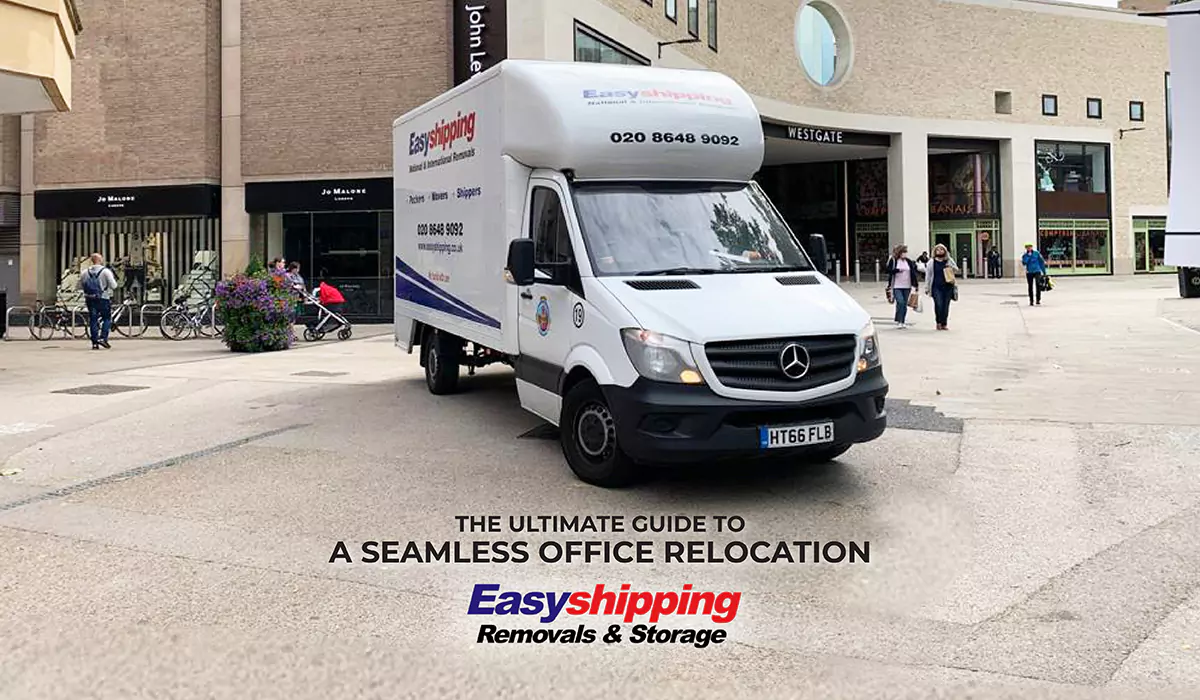Blog Summary
An office relocation represents a significant endeavour for any business, commonly driven by the need for more spacious premises, superior facilities, or a more strategic location. Whilst the benefits can be considerable, encompassing enhanced productivity and improved staff satisfaction, the process itself requires meticulous planning and execution to sidestep potential pitfalls that could disrupt operations. It is not always feasible for a company to manage the move using its own resources, and it is invariably better to handle strategic planning internally while delegating the execution of the business move to a professional commercial moving company. This comprehensive guide offers a structured approach to managing your office move, ensuring it is carried out smoothly and successfully.
- Understanding the reasons for relocation:
- Challenges encountered during the move:
- Creating a comprehensive relocation checklist
- Maintaining business operations during the transition
- Labeling and packing strategies for efficient office relocation
- Hiring professional movers for an office relocation
- Managing furniture disassembly and assembly during office relocation
- Conclusion
Understanding the reasons for relocation:
Growth and Expansion: Many businesses relocate because they outgrow their current spaces. Moving to a larger office can accommodate more employees and equipment, which is essential for scaling operations. Moving a business to a strategically located area can enhance visibility, improve client accessibility, and provide networking opportunities with business clusters.
Upgrading Facilities: Modern facilities with better technological infrastructure and amenities can boost employee morale and productivity, attracting and retaining talent. This can include moving to regions with a more skilled labor pool, better employment rates, lower rent, or lower wage scales.
Switching to Remote or Hybrid Work Models: For companies adopting permanent remote work policies, downsizing to smaller office spaces or moving to less expensive locations can reduce overhead costs significantly.
Challenges encountered during the move:
Minimizing Downtime:
One of the most significant challenges businesses face during an office move is minimizing downtime to ensure continued operational efficiency. A common strategy employed by many successful companies is the phased relocation approach, where different departments or teams move at staggered times. This allows parts of the business to remain operational while others transition. Additionally, having robust IT infrastructure preparations in place, such as setting up critical systems and networks in the new location ahead of the office removals, ensures a quick resumption of work.
Safeguarding Data and Equipment:
Protecting sensitive data and expensive hardware during a move is critical. This includes data backup before the office move and comprehensive testing of network connections and equipment functionality upon setup at the new location. Companies with extensive laboratories, furniture, or heavy machinery need movers with specific expertise. Hoist hire services can be helpful to remove large furniture easily.
Managing Change Resistance:
Resistance to change is a natural human response, and relocating office space can significantly disrupt employees’ lives. Successful companies often mitigate this by involving employees early in the planning process, maintaining transparent communication throughout the move, and highlighting the benefits of the new location.
Budget Overruns:
Planning the moving cost is one of the most common challenges during office moves. To combat this, experienced companies obtain detailed quotes and service agreements from professional office movers.

Creating a comprehensive relocation checklist
A thorough checklist is instrumental in orchestrating a smooth transition. Here’s a breakdown of key components that should be included in your office relocation checklist:
Pre-move preparations:
Select a Moving Company: Research and hire a professional moving company with experience in office relocations. Ensure they offer the specific services you need, such as furniture disassembly and reassembly, IT equipment handling, and secure transport.
Prepare the New Space: Coordinate with the facility management at the new location to prepare the space. This includes arranging for cleaning services, painting, and necessary repairs or renovations.
Schedule Utilities and Services: Set up essential services such as water, electricity, internet, and security systems to be functional before the move-in date. This ensures that the new office is operational from day one.
Document All Assets: Create a detailed inventory of all business assets. This should include computers, furniture, documents, and personal items belonging to the company. Photographing items can also be helpful for insurance purposes.
Document Auditing: Sort through all documents, securely dispose of outdated files, and identify what needs to be moved.
Label Everything: Clearly label all items and boxes with contents, handling instructions, and the designated location in the new office. This aids movers in placing items correctly and efficiently.
Update Address Details: Notify all legal entities, service providers, and clients of your new address. This includes updating your address with the postal service, banks, and in all legal documents. Advance notifications to employees, clients, and vendors about the move dates and potential disruptions are crucial.
Regulatory Compliance: Ensure that your new office complies with local zoning laws, building codes, and any other regulatory requirements. Obtain necessary permits or approvals before moving in.
Assign Tasks: Delegate specific roles and responsibilities related to the move to different team members. This could include supervising packing, and coordinating with the movers team, or setting up equipment in the new location. Coordinate with IT professionals for the disassembly, safe transport, and reassembly of technical equipment.
Troubleshooting Setup Issues: Have IT staff and facilities managers on hand during the first week to address any issues with equipment or utilities that may arise as employees settle in.
Data Protection: Implement robust data backup solutions to secure data against loss during the physical move.
Feedback and Adjustment: After the move, gather feedback from employees regarding the new space and any issues they face. Be prepared to make adjustments to the workspace based on this feedback to optimize productivity and comfort.
Insurance Coverage: Review your current insurance policies to ensure they cover all potential risks associated with moving. This includes damage or loss of office assets during packing, transportation, and unpacking. Speak with your insurance provider to adjust your policy or acquire additional coverage specific to the move. Keep detailed records and photographic evidence of the condition of items before the move. This documentation will be invaluable in case you need to file an insurance claim for damages incurred during the relocation.

Maintaining business operations during the transition
Successfully maintaining business operations during an office move is crucial to minimizing downtime and ensuring that the business continues to function efficiently.
Plan Phases Carefully: Develop a detailed schedule for moving different departments in stages. This strategy allows your business to continue operating without significant interruptions.
Test and Adjust: Begin the move with departments that are less critical to your core business operations. This approach provides an opportunity to identify and resolve any unforeseen issues that arise, ensuring that the process is refined by the time you move more critical teams.
Prioritize Based on Need: Consider the specific needs and functions of each department. For example, IT and customer service departments might be prioritized differently based on the infrastructure setup at the new location and their role in business operations.
Implement Flexible Work Policies: If not already in place, temporarily implement or expand remote work policies to allow employees to work from home during the relocation. This can help maintain normal business operations and reduce the physical and logistical burden at both the old and new locations.
Labeling and packing strategies for efficient office relocation
An effective packing strategy is crucial for ensuring that all office belongings are transported securely and can be quickly and efficiently set up at the new location.
Systematic Labeling: Every box and item should be clearly labeled with its contents and the specific area or room in the new office where it belongs. This reduces confusion and helps with placing items correctly without opening each box to check its contents.
Color-Coding System: Implement a color-coding system by department or team. For example, all boxes containing IT equipment might be labeled with blue stickers, while marketing materials might be labeled with red. This not only speeds up the unloading and unpacking processes but also helps to ensure that items don’t end up in the wrong departments.
Appropriate Packing Materials: Use the right packing materials for different types of items. Electronics should be packed with anti-static bubble wrap, while fragile items like glassware require sturdy boxes and sufficient padding to prevent damage. For highly sensitive or valuable items, professional packing service providers can help better through their years of expertise. Professionals are skilled in packing goods in a way that minimizes the risk of damage.
By implementing these labeling and packing strategies, you can streamline the office moving process, reduce the risk of item misplacement or damage, and ensure a smoother transition to the new office space.
Hiring professional movers for an office relocation
When it comes to relocating an office, selecting the right professional movers is crucial. These experts not only handle the physical aspects of business moving but also help manage the risks associated with transporting your business’s valuable assets and equipment. Here are essential considerations for hiring the most suitable professional office removal service:
Expertise in Office Moves: Choose a moving company specialising in office relocations. Such companies are experienced in handling the unique challenges of moving business environments, such as dealing with bulky furniture, sensitive IT equipment, and confidential documents. Ensure the selected mover has the capacity to handle the volume. Check their track record for moving similar-sized businesses.
Multiple Quotes: Gather quotes from professional moving companies to compare prices and service offerings. This will give you a broad market perspective and help in making an informed decision. Transparent quotation will help prevent unexpected charges and discrepancies.
Pre-Move Meeting: Arrange a detailed planning session with the chosen movers. This meeting should outline every aspect of the business move, from logistical details to specific responsibilities on moving day.
Regular Updates: Maintain open lines of communication with the moving company throughout the business relocation process. Regular updates can help address any emerging issues promptly and keep the move on track.
Insurance and Liability: Confirm that the moving company offers adequate insurance to cover potential damages during the move. Understand the terms of the insurance coverage and what it entails in case of loss or damage.
Post-Move Support: Some moving companies offer post-move support services, such as helping with unpacking and setting up the new office. Discuss these services beforehand and include them in your contract if needed.
On-Site Coordination: Assign a move manager to oversee the operation on moving day. This person should handle coordination between staff and movers, ensuring adherence to the planned schedule.
Managing furniture disassembly and assembly during office relocation
Office relocation involves not just moving items from one place to another but also the detailed tasks of furniture disassembly and assembly. Handling this aspect efficiently can save significant time and reduce the risk of damage to valuable office furniture.
Inventory and Assessment: Conduct a thorough inventory of all furniture items. Assess which items need to be disassembled and which can be moved intact. This is important for planning the necessary tools and manpower required.
Instructions and Manuals: Keep handy any original assembly instructions or manuals for office furniture. These can be invaluable for both disassembly and reassembly, ensuring that all parts are correctly handled and reassembled.
Label and Organize: As pieces are disassembled, label each part and keep all related hardware, like screws and bolts, in labeled bags attached to the corresponding furniture piece. This organization prevents loss of parts and confusion during reassembly.
Appropriate Tools: Professional movers like Easy Shipping Ltd ensure to bring the right tools for the job. Common tools needed for furniture disassembly include screwdrivers, wrenches, Allen keys, and pliers. Professional movers have the expertise to handle expensive and bulky items without causing damage.
Systematic Reassembly: Follow a structured approach to reassembly, starting with essential office furniture like desks and storage units. This allows your office to become functional as quickly as possible.
Final Inspection: Once furniture is assembled, conduct a final inspection to ensure everything is stable and correctly set up. Check for any missing components or potential issues that need to be addressed.
Conclusion
Successfully relocating an office requires more than just moving items from one place to another. It involves detailed planning, effective communication, and robust management to ensure the move is seamless and beneficial for the business’s future growth. By following the structured approach outlined in this guide, you can anticipate challenges, prepare solutions, and execute a relocation that meets the strategic needs of your business, ensuring minimal disruption and maximum benefit.


1 Comment
Comments are closed.